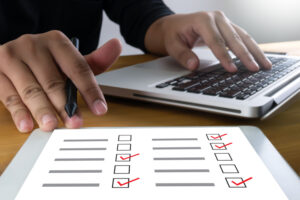
Intellicast S6E23– News Stories to Kick-Off September
September 6, 2023Harnessing the Power of In-Home Product Testing Panels
September 7, 2023Home Product Tester: Test Products at Home
With in-home product testing, every day presents a chance to turn ordinary life into an opportunity to influence the products you use. Imagine having the latest gadgets, household items, and more delivered right to your doorstep, and you get to try them out for free. That’s precisely what In-Home Product Testers do – they evaluate products in the comfort of their homes and play a pivotal role in shaping the consumer landscape.
What Are In-Home Product Testers?
In-home product testers are everyday people who join a panel to test a wide range of products in their own homes. These individuals represent diverse demographics, lifestyles, and preferences, making them a crucial part of market research. Their goal? To provide authentic, real-world feedback on products to help companies improve their offerings and make them more consumer friendly.

Purpose of In-Home Product Testing
The purpose of in-home product tests is multifaceted, including:
Creating Better Products
At its core, In-Home Product Testing aims to develop products that consumers genuinely love. By gathering feedback from real users in real-life settings, companies can refine and improve their offerings to better meet consumer needs and preferences.

Quality Assurance
Product testing helps ensure that items meet quality and safety standards. This is particularly crucial for products like appliances, electronics, and food items, where safety and functionality are paramount, and usage in the home environment gives the best real-world insights.
Target Audience Understanding
In-Home Product Testers represent diverse demographics, providing insights into consumer behavior, preferences, and trends. This information helps companies understand their target audience better.
Marketing and Branding
In-Home Product Testing helps companies gauge how their products are perceived by consumers. This insight influences branding decisions and marketing strategies, ensuring products are positioned effectively in the market.
Typical Products for In-Home Testing
There are a wide variety of products that can be studied using in-home testing. They include:
Consumer Packaged Goods (CPG)
Food and beverages, household cleaning products, personal care items (shampoos, soaps, lotions), and pet care products often undergo in-home product testing to assess taste, usability, effectiveness, and overall satisfaction.
Electronics and Technology
Gadgets like smartphones, laptops, smart home devices, and wearable technology can be evaluated for user-friendliness, performance, and compatibility within users’ daily routines.
Home Appliances
Products like kitchen appliances, vacuum cleaners, air purifiers, and washing machines can be tested at home to gauge functionality, ease of use, and impact on daily chores.

Car accessories such as seat covers, car cleaning products, air fresheners, infotainment systems, and other accessories can be evaluated for satisfaction, usability, and more.
Home Furnishings
Furniture, bedding, home decor, and lighting can be evaluated using in-home testing to understand comfort, aesthetics, and suitability for different living spaces.
Children’s Products
Toys, baby care items, clothing, and educational tools often undergo in-home testing to determine safety, durability, entertainment value, and developmental impact.
Health and Wellness
Fitness equipment, dietary supplements, wellness products, and medical devices can be assessed to understand user experiences, results, and overall satisfaction.

In-home testing can be used to assess the fit, comfort, durability, and style appeal of clothing, footwear, and accessories.
Outdoor and Recreation
Products like camping gear, sporting equipment, outdoor apparel, and gardening tools can be tested to gauge performance, durability, and user satisfaction.
Household Essentials
Everyday items like paper products (tissues, toilet paper), cleaning tools (mops, brooms), and storage solutions can be tested to gauge performance, durability, and user satisfaction.
Beauty and Skincare
Cosmetics, skincare products, hair styling tools, and fragrances are commonly tested through in-home product testing to assess effectiveness, user experience, and visual appeal.
Entertainment and Media
Assess consumers’ media consumption experiences, such as video streaming services, books, magazines, gaming consoles, etc.
What Do In-Home Product Testers Do?
The primary responsibility of in-home product testers is to assess and offer feedback on products within the comfort of their own homes. Testers, also known as participants, are carefully chosen based on factors like demographics, attitudes, behaviors, and usage patterns, aligning them with the target audience of the product under evaluation. Once selected, these testers receive the product in question along with comprehensive usage instructions from the market research company. The key focus is to seamlessly incorporate the product into their daily lives, mirroring how they would naturally use it. During this phase, testers meticulously document their experiences, opinions, and insights. This valuable feedback aids companies in gaining a deep understanding of how their products perform in real-life scenarios.

Product Testing: Beyond the Tester’s Home
While the heart of in-home product testing is to experience products in your own environment, it often extends beyond your doorstep. When it comes to providing feedback, testers could be invited to attend focus groups or participate in surveys to provide additional insights. Your role as a tester isn’t confined solely to your home; it’s about being part of a broader conversation that shapes product development.
How Do In-Home Product Testers Make Money?

In-home product testers aren’t providing their feedback just to be able to test products; they can also earn rewards for their input. Testers can be compensated for their time and insights with cash, gift cards, points, or free products. Some testers even participate in sweepstakes or have the chance to keep the products they’ve evaluated.
The Role of In-Home Product Testing in Market Research
In-home product testing is a valuable tool that allows companies to bridge the gap between product conception and market acceptance, leading to more successful product launches and improved consumer satisfaction. It is multifaceted and essential for several reasons:
Understanding Market Trends
In-home product testers serve as the eyes and ears of the market research world. Their experiences and opinions shed light on emerging trends, preferences, and consumer behaviors, helping companies stay ahead of the curve.
Improving Product Quality and Functionality
One of the key roles of in-home product testing is to identify product strengths and weaknesses. Testers provide constructive feedback that guides companies in enhancing product quality, functionality, and safety.
light on emerging trends, preferences, and consumer behaviors, helping companies stay ahead of the curve.
Improving Product Quality and Functionality
One of the key roles of in-home product testing is to identify product strengths and weaknesses. Testers provide constructive feedback that guides companies in enhancing product quality, functionality, and safety.
Shaping Product Branding and Marketing Strategies
How a product is perceived by consumers is crucial. in-home product testers’ insights influence branding decisions and marketing strategies. Your feedback can help companies position their products effectively in the market.

Getting Involved in Home Product Testing
Getting involved in in-home product testing can be an exciting way to try out new products, share your opinions, and potentially earn rewards. The best way to start participating is to join an online panel. Look for ones that offer in-home product testing opportunities and sign up. Based on your profile when you register, you will start to see opportunities that are relevant to you.
The Do’s and Don’ts of In-Home Product Testing
Do's of In-Home Product Testing
Follow Instructions: Always read and follow the provided instructions carefully. This ensures you’re using the product correctly and as intended.
Keep Detailed Records: Maintain a thorough record of your experiences with the product. Note your usage details, any changes observed over time, and your overall impressions.
Provide Constructive Feedback: Be honest in your feedback and offer constructive criticism. Explain what you liked, what you disliked, and any suggestions for improvement.
Stay Organized: Keep all product-related materials, such as packaging and instructions, in one place. This makes it easier to reference them when providing feedback.
Meet Deadlines: If there are deadlines for completing surveys or providing feedback, make sure to meet them promptly. Timeliness is crucial for the testing process.
Maintain Confidentiality: If you’re asked to sign a confidentiality agreement, respect it by not sharing sensitive information about the product or the testing process.
Report Safety Concerns: If you encounter any safety issues while using the product, report them immediately to the panel or market research company. Safety should always come first.
Engage and Communicate: Stay engaged with the market research company or panel. Check for updates, respond to emails, and communicate any issues or questions that arise.
Don’ts of In-Home Product Testing
Exaggerate: Avoid exaggerating your feedback, whether positively or negatively. Provide honest assessments that reflect your true experiences.
Share Confidential Information: Refrain from sharing sensitive details about the product, the testing process, or any proprietary information you might come across. Sharing this information can exclude you from future testing opportunities and potentially include other penalties.
Miss Deadlines: Failing to meet deadlines for feedback or surveys can disrupt the testing process and affect the reliability of results.
Skip Documentation: Don’t neglect to document your experiences and impressions. Detailed records are essential for providing valuable feedback.
Disclose Personal Information: Be cautious about sharing personal information beyond what’s required by the panel or market research company. Protect your privacy. If you are asked for something you are not comfortable with, reach out to the panel or market research firm and ask questions.
Use the Product Inappropriately: Use the product only as directed. Avoid using it for purposes other than those specified in the instructions.
Forget About Follow-Up: If you’re asked to provide follow-up feedback after some time, don’t neglect this step. It’s valuable for assessing long-term product performance. Additional incentives are usually given for this that you would not be eligible for without it.
Ignore Communication: Stay responsive to emails and messages from the testing panel or company. Ignoring communication can result in missed opportunities.
From testing within the comfort of your own home to participating in broader discussions about product development, you are a vital part of understanding market trends, improving product quality, and shaping branding and marketing strategies. Your input matters and companies value your authentic experiences and feedback. As you embark on this exciting path, remember the tips and guidelines to maximize your testing experiences, provide valuable insights, and enjoy the perks of being a tester. Your contributions drive innovation and ensure that consumer goods continually evolve to meet your expectations.





